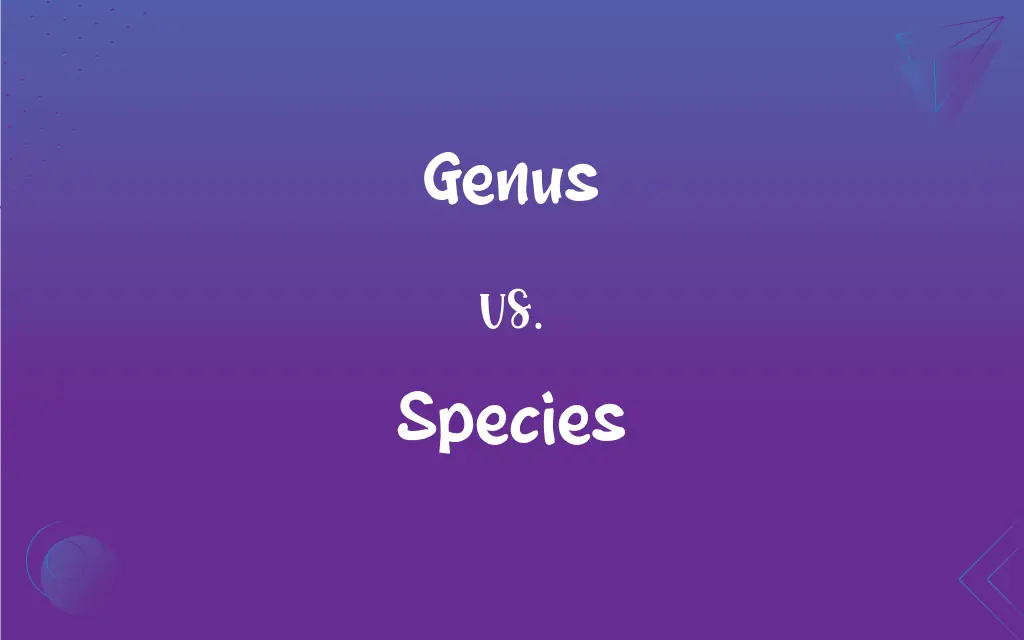Genus vs. Species: What's the Difference?
Edited by Janet White || By Harlon Moss || Updated on October 13, 2023
A genus is a classification grouping multiple species, while a species represents individual organisms sharing common characteristics and genetic makeup.

Key Differences
In the hierarchy of biological classification, the genus stands above species. A genus encompasses a group of species that are structurally similar or evolutionarily related. Meanwhile, species is the most specific level of classification, representing a group of individuals that can interbreed and produce fertile offspring.
The concept of a genus revolves around broader similarities among different species. Within a single genus, multiple species may exist, but they share certain structural or evolutionary traits. On the other hand, the distinction of species is based on more detailed commonalities, typically at a genetic level.
When naming organisms using binomial nomenclature, the genus comes first with an initial capital letter, followed by the species, which is always in lowercase. For instance, in "Homo sapiens," "Homo" represents the genus, and "sapiens" represents the species.
A genus, by its nature, is more encompassing and general. It groups together organisms that, while closely related, may have distinct differences. A species, conversely, is defined by its specificity. Members of the same species are more alike than those simply in the same genus.
The delineation between different species within a genus can often be intricate, relying on subtle differences in behavior, genetic makeup, or reproductive capability. In contrast, the distinction between various genera (plural of genus) typically rests on more apparent, broader differences.
ADVERTISEMENT
Comparison Chart
Definition
A classification grouping several species.
The most specific level of classification.
Hierarchy
Above species.
Below genus.
Naming Convention
Capitalized in binomial nomenclature.
Lowercase in binomial nomenclature.
Breadth
Broader, includes multiple species.
Specific, focused on individual organisms.
Interrelation
May contain multiple species.
Is a subset within a genus.
ADVERTISEMENT
Genus and Species Definitions
Genus
A taxonomic category ranking below a family and above a species.
Both lions and tigers belong to the genus Panthera.
Species
The most basic unit in the system of taxonomy.
The Bengal tiger and Siberian tiger are two different species within the Panthera genus.
Genus
A way to group species based on structural similarities or evolutionary history.
The genus Rosa encompasses various species of roses.
Species
A classification based on shared genetic makeup and characteristics.
Though similar, dogs and wolves are distinct species.
Genus
A rank in the classification of organisms, grouping together species with similar characteristics.
The genus Canis includes wolves, coyotes, and domestic dogs.
Species
A group of living organisms capable of interbreeding to produce fertile offspring.
The human species is known as Homo sapiens.
Genus
The first part of the binomial nomenclature in taxonomy.
In the name Homo sapiens, the genus is Homo.
Species
The second part of the binomial nomenclature in taxonomy.
In the name Panthera leo, the species is leo.
Genus
A collection of species closely related in structure and evolutionary origin.
The genus Felis contains species like the domestic cat and the wildcat.
Species
A distinct group within a genus in the hierarchy of biological classification.
While the species sapiens belongs to the genus Homo, it distinctly identifies humans.
Genus
(Biology) A taxonomic category ranking below a family and above a species and designating a group of species that are presumed to be closely related and usually exhibit similar characteristics. In a scientific name, the genus name is capitalized and italicized, for example, Ovis for sheep and related animals.
Species
(Biology) A group of closely related organisms that are very similar to each other and are usually capable of interbreeding and producing fertile offspring. The species is the fundamental category of taxonomic classification, ranking below a genus or subgenus. Species names are represented in binomial nomenclature by an uncapitalized Latin adjective or noun following a capitalized genus name, as in Ananas comosus, the pineapple, and Equus caballus, the horse.
Genus
(Logic) A class of objects divided into subordinate species having certain common attributes.
Species
(Logic) A class of individuals or objects grouped by virtue of their common attributes and assigned a common name; a division subordinate to a genus.
FAQs
What is a "genus"?
A genus is a rank in the biological classification (taxonomy) that groups together species which share a set of common characteristics.
Can "genus" be used outside of biological contexts?
Rarely. It is predominantly used in biological and taxonomical discussions.
Provide a sentence using "genus".
"Lions, tigers, and leopards belong to the genus Panthera."
How do you spell "genus"?
G-E-N-U-S.
How do you spell "species"?
S-P-E-C-I-E-S.
Is "species" singular or plural?
"Species" can be both singular and plural.
Is “species” used commonly in English?
Yes, “species” is used in various contexts, especially in discussions about biology and conservation.
How is "genus" pronounced?
"Genus" is pronounced as [JEE-nuhs].
What comes first, genus or species, in taxonomic names?
The genus name comes first and is capitalized.
Can "genus" be used metaphorically?
It is not commonly used metaphorically.
Does "genus" have synonyms?
Not exactly, as it represents a specific rank in taxonomy.
Can "species" be used outside biological contexts?
Yes, sometimes metaphorically to discuss types or varieties within a general category.
What is the significance of species in biodiversity?
Different species play vital roles in ecosystems, affecting the health and stability of the environment.
Does "species" have synonyms?
Yes, but they might not be scientifically accurate as alternatives, e.g., "kind" or "sort," depending on the context.
Is "genus" singular or plural?
"Genus" is singular. The plural form is "genera".
Is "species" the same as "kind"?
Not precisely, “species” has a specific biological definition, whereas “kind” is a more general term.
Provide a sentence using "species".
"The African Elephant is a species that is vulnerable to extinction."
How is “species” pronounced?
"Species" is pronounced as [SPEE-sheez].
What is a "species"?
A species is a basic unit of biological classification and a taxonomic rank.
Is "genus" a common word in English?
It is common in scientific and biological contexts.
About Author
Written by
Harlon MossHarlon is a seasoned quality moderator and accomplished content writer for Difference Wiki. An alumnus of the prestigious University of California, he earned his degree in Computer Science. Leveraging his academic background, Harlon brings a meticulous and informed perspective to his work, ensuring content accuracy and excellence.
Edited by
Janet WhiteJanet White has been an esteemed writer and blogger for Difference Wiki. Holding a Master's degree in Science and Medical Journalism from the prestigious Boston University, she has consistently demonstrated her expertise and passion for her field. When she's not immersed in her work, Janet relishes her time exercising, delving into a good book, and cherishing moments with friends and family.































































